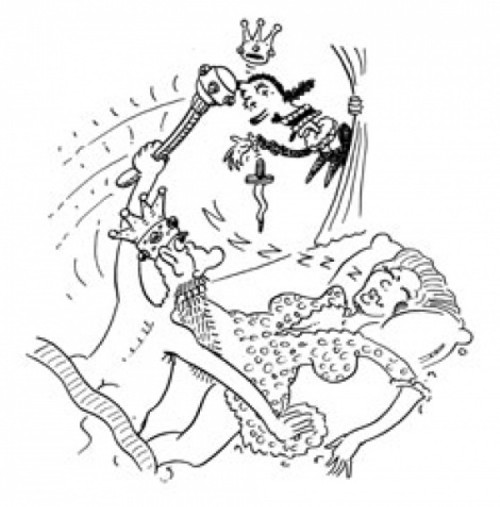Just read one of Neil Gaiman’s Sandman volumes entitled The Kindly Ones. I was taken aback when one character relates a disturbing variant of “Sleeping Beauty” described as the original version of the tale, from back before it got watered down. Is this true, or is the story something out of Neil Gaiman’s brilliant mind? —Amir
While Gaiman clearly has a way with a yarn, no, he didn’t invent the take on “Sleeping Beauty” you read—it first saw print about 375 years ago. And, yeah, I guess it is sort of creepy, if you’re the kind of person who finds necrophilia and cannibalism creepy.
The story comes from a ground-breaking collection of folktales now known as the Pentameron, assembled in the early 1600s by the Neapolitan courtier Giambattista Basile; like its namesake, Boccaccio’s Decameron, it’s structured within a framing narrative of people sitting around telling stories. Among tales of torture and bestiality we find one about a young noblewoman named Talia, who gets some lethal flax jammed under a fingernail and drops dead. Soon enough, a king out hawking, spies her inert body, feels “his blood course hotly through his veins,” and decides to make his move. Fine, he seems to believe he’s getting off not with a cadaver but with a delightful young woman who happens to be out cold, but that’s hardly an excuse.
Anyhow, he zips up and rides away. Nine months later, the still-stationary Talia gives birth to twins; while attempting to nurse, they accidentally suck the sliver out of her finger and so restore her to life. On his eventual return, the king resolves to bring Talia and the kids home with him. Unsurprisingly, his wife (yup, this charmer is married) doesn’t like the idea and attempts to have the twins cooked and fed to their dad, but she gets caught and is burned alive as punishment.
You can already hear studio execs saying, “I like it, but can we lose the rape?” Subsequent versions would oblige. A different Pentameron translation whistles right past the mechanics of procreation—the king goes no further than ogling Talia, after which some twins stroll in sans explanation. Fairy tale pioneer Charles Perrault tidied things up considerably in his 1696 version: 1. his title, “The Sleeping Beauty in the Wood,” makes clear up front that the ingénue isn’t dead but merely taking a curse-induced nap, 2. her leading man is now an unattached prince who, 3. gets no chance even to cop a feel, as the sleep spell wears off right away, and, 4. they secretly marry before having children, whom 5. the prince’s mom, ethnically an ogre, is ultimately prevented from eating. It was the Grimm brothers, in 1812, who added the crowd-pleasing wake-up kiss and thought to end the action there.
And that’s often what happens (as numerous commentators have suggested) when a folktale catches on: It starts out laden with the cruel gravitas of mythology but is gradually shorn of any elements that seem too gruesome or kinky and, next thing you know, you’re taking your kids to see it on ice.
Thus, in Perrault’s original “Little Red Riding Hood,” the wolf eats the grandmother and the girl, and that’s it: They’re dead. (Later adapters, seeing a serious flow problem in Act 3, would rewrite to include a woodsman.) The plot of “Snow White” hasn’t changed much, really, but the evil queen’s comeuppance no longer requires her to don a pair of red-hot iron shoes and dance till she dies.
Some fairy tales made it into the modern era with their inherent darkness intact. “Hansel and Gretel” did pretty well considering it’s about impoverished parents who try to balance the household food budget by leaving their kids to expire in the forest. But as times grew increasingly enlightened, other stories never had a chance. Skim some of the Grimm boys’ more obscure numbers—say, the one where the father, having made a deal with the devil, is forced to chop off his young daughter’s hands—and you’re liable to think (as did many of the Grimms’ contemporaries): You call this a kids’ book? Are you crazy?
But stories like these also serve as a vehicle for the feelings of terror preadolescents have always wanted to experiment with. As the fairy tale canon gets Disneyfied beyond recognition, new fear-delivery systems emerge. So, before we start congratulating ourselves for phasing out such tales as Perrault’s “Bluebeard,” about a homicidal control freak who fills a broom closet with the women he’s married and murdered, let’s remember a couple things: 1. famed child psychologist Bruno Bettelheim (who knew a thing or two about cruelty) argued that the seemingly arbitrary violence of fairy tales is in fact tailored to help children make sense of trauma in their own development. And, 2. if you’ve got a TV, the kids are likely watching something with that very same plot even as we speak.
Comments, questions? Take it up with Cecil on the Straight Dope Message Board, StraightDope.com, or write him at the Chicago Reader, 11 E. Illinois, Chicago 60611.
More by Cecil Adams
-
This Is the End, My Friend
This week's Straight Dope marks the last appearance of the column as the Teeming Millions have known it for the past 45 years.
- Jul 11, 2018
-
Do Brain Supplements Do Anything?
Brain Drain
- Jul 4, 2018
-
Is flying really worse for the environment than driving?
Planes and Trains
- Jun 27, 2018
- More »




